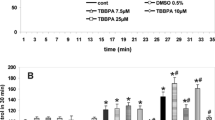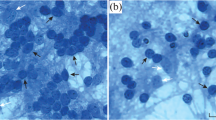Abstract
1. We have investigated the role of reactive oxygen species (ROS) in cell death induced by ischemia or application of the excitatory amino acid agonist, N-methyl-D-aspartate (NMDA) or kainate (KA), in acutely isolated rat cerebellar granule cell neurons, studied by flow cytometry. Various fluorescent dyes were used to monitor intracellular calcium concentration, ROS concentration, membrane potential, and viability in acutely dissociated neurons subjected to ischemia and reoxygenation alone, NMDA or kainate alone, and ischemia and reoxygenation plus NMDA or kainate.
2. With ischemia followed by reoxygenation, ROS concentrations rose slightly and there was only a modest increase in cell death after 60 min.
3. When NMDA or kainate alone was applied to the cells there was a large increase in ROS and in intracellular calcium concentration but only a small loss of cellular viability. However, when NMDA or kainate was applied during the reoxygenation period there was a large loss of viability, accompanied by membrane depolarization, but the elevations of ROS and intracellular calcium concentration were not greater than seen with the excitatory amino acids alone.
4. These observations indicate that other factors beyond ROS and intracellular calcium concentration contribute to cell death in cerebellar granule cell neurons.
Similar content being viewed by others
REFERENCES
Allen, C. N., Brady, R., Swann, J., Hori, N., and Carpenter, D. O. (1988). N-Methyl-D-aspartate (NMDA) receptors are inactivated by trypsin. Brain Res. 458:147-150.
Balazs, R., Jorgensen, O. S., and Hack, N. (1988). N-Methyl-D-aspartate promotes the survival of cerebellar granule cells in culture. Neuroscience 27:437-451.
Boldyrev, A. A., Johnson, P., Yanzhang, W., Tan, Y., and Carpenter, D. O. (1999). Carnosine and taurine protect rat cerebellar granular cells from free radical damage. Neurosci. Lett. 263:169-172.
Bondy, S. C., and Lee, D. K. (1993). Oxidative stress induced by glutamate receptor agonists. Brain Res. 610:229-233.
Carpenter, D. O., Stoner, C. R. T., and Lawrence, D. A. (1997). Flow cytometric measurements of neuronal death triggered by PCBs. NeuroToxicology 18:507-514.
Cheng, Y., and Sun, A. Y. (1994). Oxidative mechanisms involved in kainate-induced cytotoxicity in cortical neurons. Neurochem. Res. 19:1557-1564.
Chikahisa, L., Oyama, Y., Okazaki, E., and Noda, K. (1996). Fluorescent estimation of H2O2-induced changes in cell viability and cellular nonprotein thiol level of dissociated rat thymocytes. Jap. J. Pharmacol. 71:299-305.
Ciani, E., Groneng, L., Voltattorni, M., Rolseth, V., Contestabile, A., and Paulsen, R. E. (1996). Inhibition of free radical production or free radical scavenging protects from the excitotoxic cell death mediated by glutamate in cultures of cerebellar granule neurons. Brain Res. 728:1-6.
Countney, M. J., Lambert, J. J., and Nicholls, D. J. (1990). The interactions between plasma membrane depolarization and glutamate receptor activation in the regulation of cytoplasmic free calcium in cultured cerebellar granule cells. J. Neurosci. 10:3873-3879.
Coyle, J. T., and Puttfarcken, P. (1993). Oxidative stress, glutamate, and neurodegenerative disorders. Science 262:689-694.
Dutrait, N., Culcasi, M., Cazevieille, C., Pietri, S., Tordo, P., Bonne, C., and Muller, A. (1995). Calciumdependent free radical generation in cultured retinal neurons injured by kainate. Neurosci. Lett. 198:13-16.
Ekhom, A., Asplund, B., and Siesjo, B. K. (1992). Perturbation of cellular energy state in complete ischemia: Relationship to dissipative ion fluxes. Exp. Brain Res. 90:47-53.
Fagni, L., Lafon-Cazal, M., Rondouin, G., Manzoni, O., Lerner-Natoli, M., and Bockaert, J. (1994). The role of free radicals in NMDA-dependent neurotoxicity. Prog. Brain Res. 103:381-390.
Fawthrop, D. J., Boobis, A. R., and Davies, D. S. (1991). Mechanisms of cell death. Arch. Toxicol. 5:437-444.
Gallo, V., Kingsbury, A., Balazs, R., and Jorgensen, O. S. (1987). The role of depolarization in the survival and differentiation of cerebellar granule cells in culture. J. Neurosci. 7:2203-2213.
Gunasekar, P. G., Kanthasamy, A. G., Borowitz, J. L., and Ison, G. E. (1995). NMDA receptor activation produces concurrent generation of nitric oxide and reactive oxygen species: Implication for cell death. J. Neurochem. 65:2016-2021.
Hall, E. D., Andrus, P. K., Althaus, J. S., and VonVoigtlander, P. F. (1993). Hydroxyl radical production and lipid peroxidation parallels selective post-ischemic vulnerability in gerbil brain. J. Neurosci. Res. 34:107-112.
Halliwell, B. (1992). Reactive oxygen species and the central nervous system. J. Neurochem. 59:1609-1623.
Haugland, R. P. (1996). Handbook of Fluorescent Probes and Research Chemicals, Molecular Probes, Eugene, OR, pp. 535-536.
Kane, D. J., Sarafian, T. A., Anton, R., Hahn, H., Gralla, E. B., Valentine, J. S., Ord, T., and Bredesen, D. E. (1993). Bcl-2 inhibition of neural death: Decreased generation of reactive oxygen species. Science 262:1274-1277.
Kostyuk, P. G., and Tepikin, A. V. (1991). Calcium signals in nerve cells. NIPS 6:6-10.
Kristian, T., and Siesjo, B. K. (1996). Calcium-related damage in ischemia. Life Sci. 59:357-367.
Lafon-Cazal, M., Pletri, S., Culcasl, M., and Bockaert, J. (1993). NMDA-dependent superoxide production and neurotoxicity. Nature 364:535-537.
Lasher, R. S., and Zagon, I. S. (1972). The effect of potassium on the neuronal differentiation in culture of dissociated newborn rat cerebellum. Brain Res. 41:482-488.
LeBel, C. P., and Bondy, S. C. (1991). Oxygen radicals:Commonmediators of neurotoxicity. Neurotoxicol. Teratol. 13:341-346.
Olanow, C. W. (1993). A radical hypothesis for neurodegeneration. Trends Neurosci. 16:439-444.
Orrenius, S., Burkitt, M. J., Kass, G. E., Dypbukt, J. M., and Nicotera, P. (1992). Calcium ions and oxidative cell injury. Ann. Neurol. 32:S33-S42.
Oyama, Y., Carpenter, D. O., Chikahisa, L., and Okazaki, E. (1996). Flow-cytometric estimation on glutamate-and kainate-induced increases in intracellular Ca2+ of brain neurons: A technical report. Brain Res. 728:121-124.
Patel, M., Day, B. J., Crapo, J. D., Fridovich, I., and McNamara, J. O. (1996). Requirement for superoxide in excitotoxic cell death. Neuron 16:345-355.
Pearson, H. H., Graham, M. E., and Burgoyne, R. D. (1992). Relationship between intracellular free calcium concentration and NMDA-induced cerebellar granule cell survival in vitro. Eur. J. Neurosci. 4:1369-1375.
Pellegrini-Giampietro, D. E., Cherici, G., Alesiani, M., Carla, V., and Moroni, F. (1990). Excitatory amino acid release and free radical formation may cooperate in the genesis of ischemia-induced neuronal damage. J. Neurosci. 10:1035-1041.
Rajdev, S., and Reynolds, I. J. (1994). Glutamate-induced intracellular calcium changes and neurotoxicity in cortical neurons in vitro: Effect of chemical ischemia. Neuroscience 62:667-679.
Rasmussen, H. (1986a). The calcium messenger system: Part 1. N. Engl. J. Med. 314:1094-1101.
Rasmussen, H. (1986b). The calcium messenger system: Part 2. N. Engl. J. Med. 314:1164-1170.
Riepe, M. W., Hori, N., Ludolph, A. C., and Carpenter, D. O. (1995). Failure of neuronal ion exchange, not potentiated excitation, causes excitotoxicity after inhibition of oxidative phosphorylation. Neuroscience 4:91-97.
Saez, J. C., Kessler, J. A., Nebbett, M. V. L., and Spray, M. C. (1987). Superoxide dismutase protects cultured neurons against death by starvation. Proc. Natl. Acad. Sci. USA 84:3056-3059.
Schreiber, S. J., Megow, D., Raupach, A., Victorov, I. V., and Dirnagl, U. (1995). Age-related changes of oxygen free radical production in the rat brain slice after hypoxia: On-line measurement using enhanced chemiluminescence. Brain Res. 703:227-230.
Siesjo, B. K., and Bengtsson, F. (1989). Calcium fluxes, calcium antagonists, and calcium-related pathology in brain ischemia, hypoglycemia and spreading depression: A unifying hypothesis. J. Cereb. Blood Flow Metab. 9:127-140.
Sureda, F. X., Camins, A., Trullas, R., Camarasa, J., and Escubedo, E. (1996). A flow cytometric study of N-Methyl-D-aspartate effects on dissociated cerebellar cells. Brain Res. 723:110-114.
Taylor, M. D., Mellert, T. K., Parmentier, J. L., and Eddy, L. J. (1985). Pharmacological protection of reoxygenation damage to in vitro brain slice tissue. Brain Res. 347:268-273.
Wandenberghe, P. A., and Ceuppens, J. L. (1990). Flow cytometric measurement of cytoplasmic free calcium in human peripheral blood T lymphocytes with fluo-3, a new fluorescent calcium indicator. J. Immunol. Methods 127:197-205.
Author information
Authors and Affiliations
Rights and permissions
About this article
Cite this article
Boldyrev, A., Song, R., Dyatlov, V.A. et al. Neuronal Cell Death and Reactive Oxygen Species. Cell Mol Neurobiol 20, 433–450 (2000). https://doi.org/10.1023/A:1007066913756
Issue Date:
DOI: https://doi.org/10.1023/A:1007066913756




